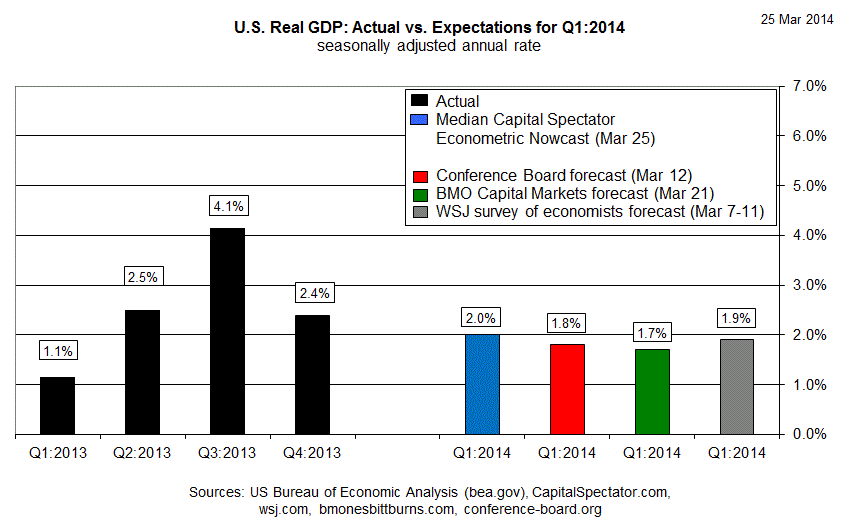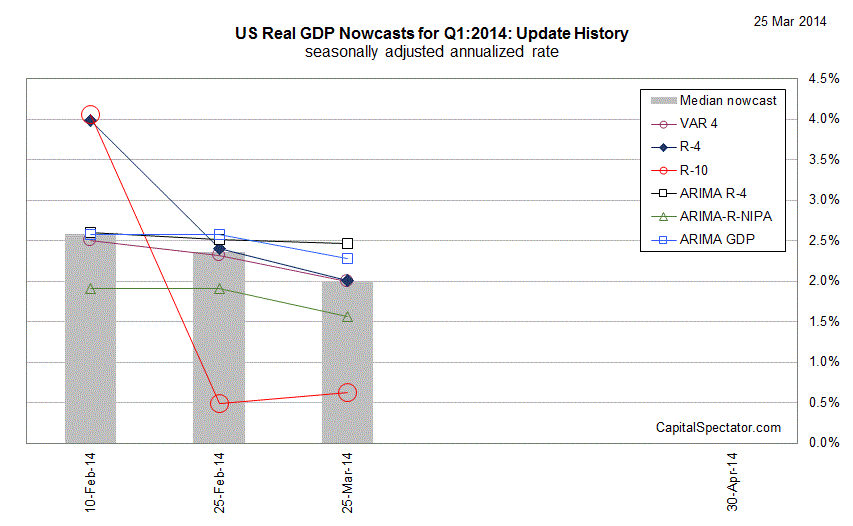It may get worse before it gets better for the US economy. GDP is expected to expand 2.0% (real seasonally adjusted annual rate) in the first three months of 2014, according to The Capital Spectator’s median nowcast. The revised estimate is below the previous 2.4% nowcast for Q1:2014 that was published on February 25.
Winter, it seems, is still squeezing the economy in terms of crunching the numbers for estimating the trend in the recent past. Or is there something darker lurking in the shadows? It’s hard to say for sure at this point, although most economists are still projecting a stronger run of growth in the spring and beyond. Harsh weather conditions cut nearly one half of one percentage point from first-quarter real GDP growth, according to the National Association of Business Economics (NABE). In a new survey of economists released yesterday, NABE said GDP will advance by just 1.9% in Q1 before growth picks up to 3.0% by the end of the year. “Conditions in a variety of areas—including labor, consumer, and housing markets—are expected to improve over the next two years, while inflation remains tame,” advised NABE President Jack Kleinhenz.
Maybe, but first the crowd has to deal with the softer numbers that are expected for this quarter. The Capital Spectator’s current 2.0% nowcast for Q1 GDP is in line with a number of estimates, including the projection of 1.9% growth for the quarter via The Wall Street Journal’s recently published March survey of economists. The official number–the “advance” estimate for Q1 GDP from the US Bureau of Economic Analysis (BEA)–is scheduled for release at the end of next month, April 30.
Meantime, the government will publish a revision of Q4:2013 GDP on Thursday (Mar. 27) and the consensus forecast (according to Briefing.com) calls for a slightly higher rate of growth: 2.6% vs. BEA’s current 2.4% estimate.
As for this year’s first quarter numbers, here’s how The Capital Spectator’s revised Q1 nowcast compares with recent history and several forecasts from other sources:
Next, let’s review the individual nowcasts that are used to calculate the median estimate:
Here’s how the Q1:2014 nowcast updates compare so far:
Finally, here’s a brief profile for each of The Capital Spectator’s GDP nowcast methodologies:
R-4: This estimate is based on a multiple regression in R of historical GDP data vs. quarterly changes for four key economic indicators: real personal consumption expenditures (or real retail sales for the current month until the PCE report is published), real personal income less government transfers, industrial production, and private non-farm payrolls. The model estimates the statistical relationships from the early 1970s to the present. The estimates are revised as new data is published.
R-10: This model also uses a multiple regression framework based on numbers dating to the early 1970s and updates the estimates as new data arrives. The methodology is identical to the 4-factor model above, except that R-10 uses additional factors—10 in all—to nowcast GDP. In addition to the data quartet in the 4-factor model, the 10-factor nowcast also incorporates the following six series: ISM Manufacturing PMI Composite Index, housing starts, initial jobless claims, the stock market (S&P 500), crude oil prices (spot price for West Texas Intermediate), and the Treasury yield curve spread (10-year Note less 3-month T-bill).
ARIMA GDP: The econometric engine for this nowcast is known as an autoregressive integrated moving average. This ARIMA model uses GDP’s history, dating from the early 1970s to the present, for anticipating the target quarter’s change. As the historical GDP data is revised, so too is the nowcast, which is calculated in R via the “forecast” package, which optimizes the parameters based on the data set’s historical record.
ARIMA R-4: This model combines ARIMA estimates with regression analysis to project GDP data. The ARIMA R-4 model analyzes four historical data sets: real personal consumption expenditures, real personal income less government transfers, industrial production, and private non-farm payrolls. This model uses the historical relationships between those indicators and GDP for projections by filling in the missing data points in the current quarter with ARIMA estimates. As the indicators are updated, actual data replaces the ARIMA estimates and the nowcast is recalculated.
VAR 4: This vector autoregression model uses four data series in search of interdependent relationships for estimating GDP. The historical data sets in the R-4 and ARIMA R-4 models noted above are also used in VAR-4, albeit with a different econometric engine. As new data is published, so too is the VAR-4 nowcast. The data sets range from the early 1970s to the present, using the “vars” package in R to crunch the numbers.
ARIMA R-NIPA: The model uses an autoregressive integrated moving average to estimate future values of GDP based on the datasets of four primary categories of the national income and product accounts (NIPA): personal consumption expenditures, gross private domestic investment, net exports of goods and services, and government consumption expenditures and gross investment. The model uses historical data from the early 1970s to the present for anticipating the target quarter’s change. As the historical numbers are revised, so too is the estimate, which is calculated in R via the “forecast” package, which optimizes the parameters based on the data set’s historical record.



Pingback: Q1:2014 US GDP Nowcast: +2.4%